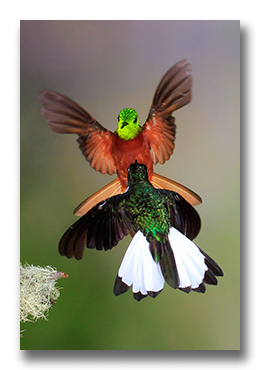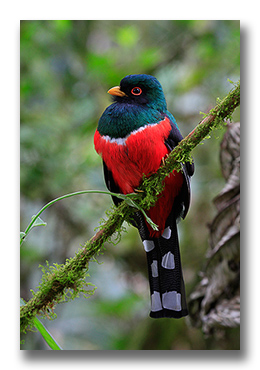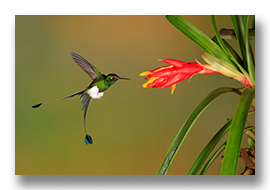
We've all seen them. Those
remarkable photographs of beautiful hummingbirds
frozen in flight. You may have thought that
capturing images like these was entirely out of
reach. You might not even know where to
begin.
You begin right here!!!
Join Mark Thomas in
Ecuador, a country that boasts
some 130
hummingbird species, and pictures like these
can become a reality. You don't need any specialized
equipment or training. Mark provides all of that and
more. You simply need your digital SLR camera, a
lens of about 200mm (a good zoom lens works best), a
tripod and the desire to capture incredible images
of these flying jewels.
Mark has been a
professional wildlife photographer for over 25 years
and has photographed on every continent from Africa
to Antarctica. He is also an accomplished underwater
photographer. But his recent trip to Ecuador to
photograph its magnificent hummingbirds was unlike
any photography he had done in the past. One of the
keys to capturing images like those you see
here is spending the maximum amount of time at each
location. Only then are you able to learn
the unique behaviors of each species, and more
importantly, of
individual birds. Everybody
gets pictures of hummingbirds feeding at flowers.
And while those images are indeed beautiful, the
photographs that capture behaviors and interactions
are often even more dramatic. Mark strives
to capture these exciting shots. That's where the
time, dedication and love of his subjects makes all
the difference. "When you take the time to really learn your subjects, they will
often present you with amazing photographic opportunities."
In fact, one of the images Mark captured on this
trip will hang in the Smithsonian Museum of Natural
History as a category
WINNER in the Nature's Best
Photography Windland Smith Rice International
Photography Competition.
 Take
advantage of what Mark has learned and is eager to
share by joining him at the EXACT SAME LOCATIONS
where all of these pictures were taken. He captured
remarkable images of over 2 dozen hummingbird species in less
than 2 weeks. You can do it too! Take
advantage of what Mark has learned and is eager to
share by joining him at the EXACT SAME LOCATIONS
where all of these pictures were taken. He captured
remarkable images of over 2 dozen hummingbird species in less
than 2 weeks. You can do it too!
Mark provides all of the
specialized equipment needed such as strobes,
triggers, light stands and backgrounds. Variety is
the key. Not only as it relates to
different species, but also to different
environments, lighting and behaviors. To that end,
he adjusts the strobes, flowers and
backgrounds to give you the most variety of
photographic opportunities possible. He is
especially alert to behavior patterns of his
subjects. And nowhere is that more important than
when photographing hummingbirds. They are like
lightning. And the only way to get the really
exciting shots, is to be able to anticipate their
behavior and be ready. This is the challenge that
Mark loves the most.
This trip is truly a
workshop and not simply a tour (What's
the Difference?). While there will be ample opportunities for you to hike the many trails
surrounding the lodges and see other unique species
such as masked trogons, torrent ducks and tanagers
(Guided day-trips can be arranged if you like at
additional cost) this particular trip concentrates
on capturing those once-in-a-lifetime images of
hummingbirds in flight. We stay in very comfortable
lodges on both sides of the Andes. Each room has a
private bathroom with hot water. In most cases, we
will be shooting only a few steps from our rooms.
The flash setups will be available to you from dawn
until dusk each day. Even on our 'travel days' we
usually get at least a half day of shooting in at
our destinations. How long and often you shoot is
entirely up to you. Along with a variety of hummingbird feeders, the
lodges also put out fruit to
attract other species. One lodge even leaves the
outside lights on at night to attract moths which
then often attract
the magnificent masked trogon to within easy camera
range.
Besides his expertise in the field, Mark has
also been working with Photoshop to build web sites since before digital photography
even existed. He still exhibits at juried fine art
shows across the country and prints every piece
he displays himself, even on canvas. While he
believes that a good photographer makes all the
decisions BEFORE releasing the shutter (like in the
film days) and that only minimal adjustments should
need to be made after the fact, there are those
times when knowing how to "fix" an image after it
was taken can be a life-saver. Mark will show you
how to do exactly that.
Here
is a quick glimpse of some of what he shares
with you:
- Camera settings (ISO, Aperture, Shutter Speed
etc...), how to choose them and when to use them (take your camera
off of "Automatic" and feel comfortable doing so)
- How your camera's exposure meter works and when to trust
it or override it
- How to work with multiple flash setups in the field
- Why you never ever ever make adjustments to a JPEG (that doesn't mean
that you can't shoot JPEGS)
- RAW or JPEG, how they differ and which is right for you
- Many non-destructive ways of adjusting your images in
Photoshop
- Removing "flaws" (like that bug that flies into the frame)
using 'layers' and 'masks'
- How to resize images for e-mail, web use, or printing
(including printing on canvas)
- The actual workflow and adjustments he uses to take an image from camera
to printer / stock agency / e-mail
- And even how to make Photoshop do repetitive tasks to an
entire folder of images while you're at lunch with
friends
... and so much more.
Mark is happy to share
his photographic knowledge. So feel free to ask him
about non-hummingbird related topics too. You may
even find it helpful to take a few notes along the
way. But don't
worry ... there won't be a quiz!
Why Ecuador?
Besides the overall
birdlife and the unparalleled number of hummingbird
species, traveling to Ecuador is easy.
- A short, 4-hour flight from Miami
- Same time zone as Miami (in fact, Quito is actually EAST of Miami)
- Same 120 Volt electricity as the U.S.
- The US dollar is the official currency of Ecuador
- Great Value for your Money
- And did I mention the HUMMINGBIRDS?
Trip Itinerary:
|
Day 1: |
Arrive in
Quito. Transfer to your hotel. We stay at a
very nice hotel with a restaurant and Wi-Fi. |
|
Day 2: |
Breakfast at hotel.
Transfer to our lodge in the western Andes.
Arrive before lunch. Mark will
prepare the flash setups while you get
acquainted with the lodge and property.
After lunch, the hummingbirds await.
There will be at least 2 flash setups and
each photographer will rotate to each one so
everyone gets a chance at every location and
background. |
|
Day 3: |
Hummingbird
photography. |
|
Day 4: |
Hummingbird
photography. |
|
Day 5: |
Hummingbird
photography. |
|
Day 6: |
Hummingbird
photography. |
|
Day 7: |
Hummingbird
photography. |
|
Day 8: |
After
breakfast we transfer to our lodge on the
other side of the Andes for an entirely
new batch of hummingbirds. We arrive in time
for lunch. Mark will set up the equipment and you'll be shooting shortly after
lunch. |
|
Day 9: |
Hummingbird
photography. |
|
Day 10: |
Hummingbird
photography. |
|
Day 11: |
Hummingbird
photography. |
|
Day 12: |
Hummingbird
Photography up through lunchtime. Leave for
Quito after lunch. Dinner at the
hotel. |
|
Day 13: |
Depart Quito
for Home |
|
Next Day |
Make your
friends jealous with the pictures you
captured |
 |
 |
What's Included in the price?
-
Accommodations at all Lodges as well as
the hotel in
Quito
-
Meals from Breakfast on Day 2 through
Dinner on Day 12
-
All Ground Transportation between Quito
and Both Lodges
-
Use of multiple flash setups
-
Tips for Lodge and Kitchen Staff
What's Not Included in the price?
-
Airfare to Quito, Ecuador
-
Alcoholic Drinks and Sodas
-
Any excursions or guides not included in
itinerary
-
Laundry, phone and other personal items
-
Cost of hospitalization and evacuation
if necessary
|
What's the next step?
-
Contact Mark at
mark@blueiceberg.com if you have any
further questions
-
You can register with Mark at the above
e-mail address.
-
Send in your deposit early to guarantee your
space.
We hope you can
join us on what promises to be a fun and
exciting trip.
Click here to see more hummingbird
photos from Mark's trip in December,
2012. |
|
Detailed information along with a list of
recommended items that you should bring will
be provided after deposit is received. The lodges are in
remote locations in the Ecuadorian cloud
forest. Unfortunately, they are not
wheelchair accessible
at this time.
While this trip is not physically demanding,
all participants should be able to climb at
least two flights of stairs comfortably.
A signed liability waiver is a prerequisite
for attending this workshop. We reserve the right to refuse any person
from attending.
|
|

